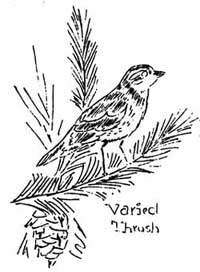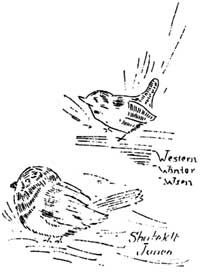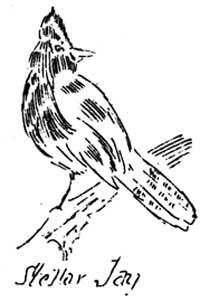|
MOUNT RAINIER NATURE NEWS NOTES
|
| Vol. VI |
December, 19228 Winter Season |
No. 9 |
WINTER BIRDS --

|

|
Winter would be a drab sort of affair, even in its dazzeling beauty,
were it no for the presence of our winter birds. Late in the fall the
Varied Thrush is quite in evidence about Longmire. He is a
handsome bird, about the size of a Robin and his characteristic markings
-- a bright orange-yellow breast, a stripe of the same color above his
eye and a black breast band -- make it easy to identify him. Port and
saucy is the Western Winter Wren, smallest of our winter birds
and this little brownish fellow seems rather out of place among the huge
trees of the forest where he lives.
|
|
Another midget is the Sierra Creeper, a small mottled brown
and grey bird. We often see him clinging to the tree trunks examining
them for insects which he extracts with his slender curved beak. The
Shufeldt Junco with his jet black head and breast, grey back and
white underparts is a real winter bird. We often see these friendly
fellows who always seem so plump as though they just had a square meal,
begging for more about the homes at Longmire.
|

|
|

|
And speaking of handouts, a Camp Robber flew to my window recently
and boldly tried to steal a piece of toast that lay within. They fact
that the window pane obstructed his progress didn't deter him a particle
for he tried several times before he became discouraged and flew away.
The Camp Robber's cousin, the Stellar Jay, is always quite in
evidence in the Park and his noisy call is bedlam when he gets it going.
There are many others - the Chickadee (on the cover) with his sharp, penetrating call, "dee
dee dee" that breaks the forest stillness, is also readily recognized
along the winter trail.
|
Click to see a copy of the original page of this
article (~120K)
|

